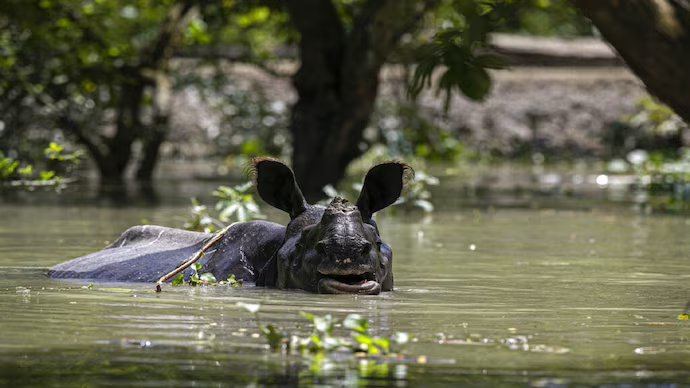The devastating floods in Assam have taken a heavy toll on the wildlife of Kaziranga National Park, with 137 animals, including six rhinos, losing their lives. The park authorities have managed to rescue 99 animals, including two rhino calves and two elephant calves, but the loss of life is still significant.
Sonali Ghosh, the field director of Kaziranga National Park, reported that 104 hog deer, six rhinos, and two sambars died after drowning in flood waters. Additionally, two hog deer were killed by vehicles, one otter pup died due to other reasons, and 22 animals died while under care.
“So far we have rescued 99 animals including two rhinos, two elephants, 84 hog deer, three swamp deer, and two sambar,” Ghosh said. However, the situation remains dire, as 70 out of 233 forest camps in the park are still underwater.
The floods have not only affected the wildlife but also the human population in Assam. As of July 8, 2024, the death toll had risen to 72, with six more people dying on Money. Over 27.74 lakh people in 28 districts are still affected by the floods.
The flood-affected districts include Goalpara, Nagaon, Nalbari, Kamrup, Morigaon, Dibrugarh, Sonitpur, Lakhimpur, South Salmara, Dhubri, Jorhat, Charaido, Hojai, Karimganj, Sivasaga, Bongaigaon, Borpeta, Dhemaji, Hailakandi, Golaghat, Darrang, Biswanath, Cachar, Kamrup (M), Tinsukia, Karbi Anglong, Chirang, Karbi Anglong West, and Majuli.
Rescue teams from the NDRF, SDRF, Fire & Emergency Services, local administration, Indian army, and paramilitary forces are all engaged in rescue operations in different areas of the state.
The severe flood situation in Assam over the past month has resulted in the loss of life, extensive damage to infrastructure, road closure, crop destruction, and livestock loss. The deluge has also left hundreds of people homeless and unsettled.
Kaziranga National Park: A Biodiversity Hotspot
Kaziranga National Park is a UNESCO World Heritage Site located in the Golaghat and Nagaon districts of Assam. It is known for its rich biodiversity, particularly its population of Indian one-horned rhinoceros.
The park is home to more than 2,200 one-horned rhinoceroses, which account for over 70% of the global population of this species. It also hosts a significant population of other endangered species, such as the Eastern Swamp Deer, Wild Water Buffalo, and Hoolock Gibbon
Kaziranga National Park is a major tourist attraction, drawing visitors from around the world to witness its unique wildlife and natural beauty. The park’s ecosystem is closely tied to the Brahmaputra River, which provides essential resources for the animals and supports the park’s biodiversity.
Impact on Wildlife Conservation
The loss of 137 animals, including six rhinos, is a significant setback for wildlife conservation efforts in Kaziranga National Park. Rhinos, in particular, are a highly endangered species, and the death of six individuals represents a substantial loss for the park’s population.
The floods have also impacted other endangered species, such as hog deer and sambar, which are important components of the park’s ecosystem. The loss of these animals can have cascading effects on the overall health and balance of the park’s biodiversity.
To mitigate the impact of the floods on wildlife, park authorities have taken several measures, including the rescue of animals and the establishment of relief camps. However, the long-term effects of the flood on the park’s ecosystem and wildlife populations remain to be seen.
Challenge and Solutions
The floods in Kaziranga National Park highlighted the ongoing challenges faced by wildlife conservation efforts in the region. Climate change and extreme weather events, such as floods and droughts, are becoming more frequent and severe, putting additional pressure on already vulnerable ecosystems.
To address these challenges, a multi-pronged approach is necessary. This includes:
- Strengthening disaster management and response capabilities to ensure the safety of wildlife and park personnel during extreme weather events.
- Enhancing habitat restoration and management efforts to improve the resilience of the park’s ecosystem to climate change impacts.
- Promoting sustainable tourism practices that minimize the impact on wildlife and their habitats.
- Fostering collaboration between government agencies, conservation organizations, and local communities to develop and implement effective conservation strategies.
- Investing in research and monitoring to better understand the impacts of climate change on wildlife populations and develop targeted conservation interventions.
Conclusion
The devastating floods in Assam have taken a heavy toll on the wildlife of Kaziranga National Park, with the loss of 137 animals, including six rhinos. This tragedy highlights the urgent need to address the challenges posed by climate change and extreme weather events to wildlife conservation efforts.
By working together to strengthen disaster management capabilities, enhance habitat restoration, promote sustainable tourism, and invest in research and monitoring, we can help protect the unique biodiversity of Kaziranga National Park and ensure the long-term survival of its iconic species, such as the one-horned rhinoceros. The loss of life in this tragedy is a sobering reminder of the fragility of our natural world and the importance of taking action to safeguard it for future generations.
